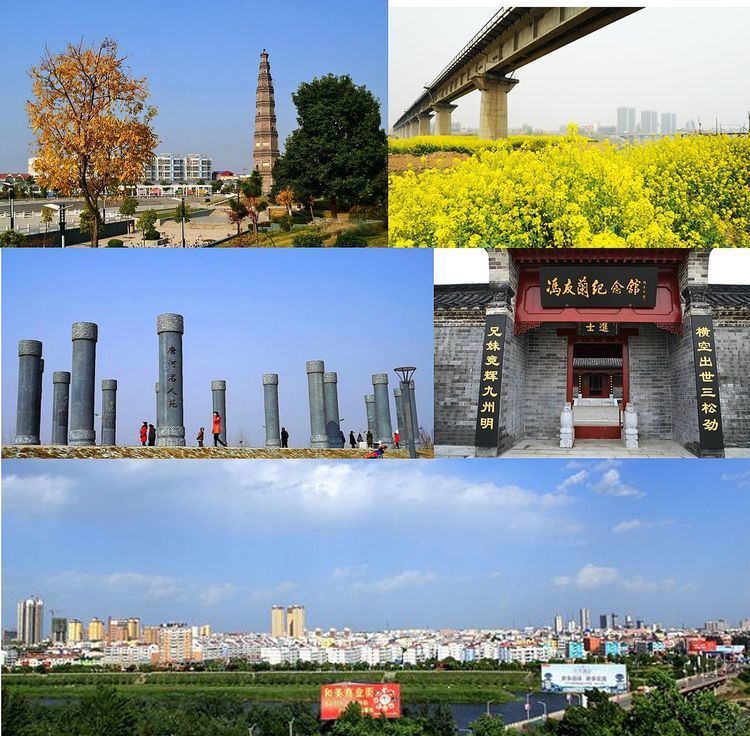Traditional Chinese 唐河縣 Hanyu Pinyin Wade–Giles T'ang-ho hsien | Simplified Chinese 唐河县 Hanyu Pinyin Area 2,497 km² | |
 | ||
Tanghe County is administered by Nanyang, Henan, People's Republic of China. Its ancient name was Tangzhou (唐州).
Contents
Map of Tanghe, Nanyang, Henan, China
The county consists of 3 subdistrict offices, 12 towns, 7 townships, and 525 administrative villages (or community), with the population being approximately 1,430,000 and total area being 2,512 square kilometres (970 sq mi). Tanghe has more than 350,000 citizens in those 3 subdistrict offices (include Binhe, Wenfeng and Xingtang), and the county government is located in the Binhe subdistrict office. The urban area expands very quickly, especially westwards, under the background of estate boom across China. The local economy is mainly based on agriculture, including wheat, cotton, pears. The investment and support from the Tanghers who work out of Tanghe is very important to the local economy.
History
In the first year of Zhenguan (672 A.D.) of Tang Emperor Taizong, the Shangma County was be incorporated to the Huyang County, and the Huzhou (湖州) state was abolished and be changed to Tangzhou (唐州) (the State government in Zaoyang now). In the 9th year of Tang Emperor Taizong, the State government was moved to Biyang (比阳) (the Biyang now). In the 13th year of Kaiyuan (725 A.D.) of Tang Emperor Xuanzong, re-established the Shangma County divided from Huyang County, and all belong to the Tangzhou State. In the 1st year of Tianbao (742 A. D.) of Tang Emperor Xuanzong, the Shangma County was renamed Biyang (泌阳) County (the County government is near the urban district of Tanghe County now), and belongs to Tangzhou State. In the 3rd year of Tianyou (906 A.D.) of Tang Emperor Aidi, the state government was moved from Biyang (比阳) to Biyang (泌阳) (now the urban district of Tanghe County), and Tangzhou State was renamed to Bizhou (泌州) State.
In the 11th year of Shaoxing (1141 A.D.) of Song Emperor Gaozong, was belongs to Jin Kingdom, and return to South Song in the 31st year of Shaoxing. In the 2nd year of Longxing (1164 A. D.) of South Song Emperor Xiaozong, was belongs to Jin Kingdom. In the alternately of South Song and Jin, the attribute had no changed. In the 6th year of Jiading of South Song Emperor Ningzong, also the 1st year of Zhining of Jin Emperor Weishao (1213 A.D.), the Huyang County was abolished and incorporated to Biyang (泌阳) County (now Tanghe) as Huyang Town, and belongs to Tangzhou State. In the 1st year of Duanping (1234 A.D.) of South Song Emperor Lizong, the Jin Kingdom was eliminated by the union of Mongol Kingdom and Song Kingdom, the Biyang (泌阳) County (now Tanghe) returned to South Song and belongs to Tangzhou State.
In the 2nd year of Zhiyuan (1265 A.D.) of Yuan Emperor Shizu Kublai Khan, the Huyang County was re-established separate from the Biyang County (now Tanghe) and belongs to Tangzhou State. At this time, the Tangzhou State administered Biyang (泌阳) (now tanghe), Huyang, Biyang (比阳) (now Biyang) and Tongbai this four Counties. In the 3rd year of Zhiyuan (1266 A.D.), the Huyang, Biyang (比阳) and Tongbai Counties were abolished and set Huyang, Biyang (比阳) and Tongbai Town, respectively, and incorporated to Tangzhou State. Then the Biyang (泌阳) (now tanghe) was incorporated to Tangzhou State too. At this time, the Tangzhou State had no County to administrate at all, and belongs to the Jiangbei Road of Henan. In the 8th year (1271 A.D.), belongs to Nanyang Fu (府).
In the 2nd year of Hongwu (1369 A.D.), the Tangzhou State was abolished and set Tang County (govern the urban district of now Tanghe), belongs to Nanyang Fu. In the 14th year (1381 A.D.), the Biyang (比阳) Town was separated from Tang County and set Biyang (泌阳) County (govern the now Biyang County). In the 12th year of Chenghua (1476 A.D.), the Tongbai Town was separated and set Tongbai County (govern the now Tongbai County).
Inheritance and followed the system of Ming Dynasty.
In the beginning year was Tang County, belongs to Nanyang Fu. In the 2nd year of ROC (1913 A.D.), renamed the Biyuan (沘源) County, belongs to Yunan (South Henan) Road. In the 3rd year, changed and belongs to Ruyang Road. In the 12th year, renamed Tanghe County, belong to Ruyang Road. In the 16th year, the Ruyang Road was abolished, the County belongs to Henan Province. In the 21st year, changed and belongs to the Sixth District Chief Inspector of Henan Province.
In November of the 37th year, the County was captured by the PLA. In December 28, the Tanghe County (also named Tangbei County, government located in the now urban district ), Tangnan County (dominate the south of Sanjiahe River, government located in the now Qiyi Town) were established. In the August of next year, the Tangxi County (government located in the now Zhangdian Town). In 1947 – 1948, the Tanghe (or Tangbei), Tangnan and Tangxi Counties in the territory, and all belongs to the First Patriotic Democratic Chief Inspector of Tongbai Region. In the winter of 37th year of ROC, the Tanghe (Tangbei) County was changed and belongs to the Second Patriotic Democratic Chief Inspector of Tongbai Region. In March of the 38th year, the Tanghe (Tangbei), Tangnan and Tangxi County merge into Tanghe County, the county government located in now Tanghe County, belongs to Nanyang Region.
Named Tanghe County, still belongs to Nanyang Region.
Transport
Public transportation
Connections between Tanghe city and all its towns are provided by buses.
